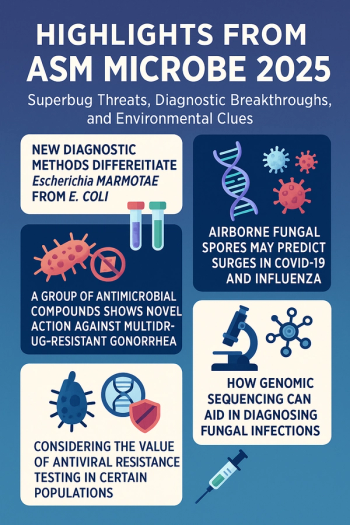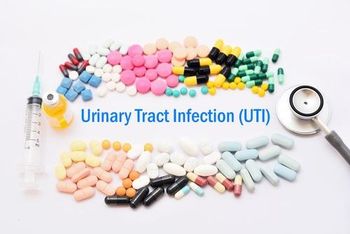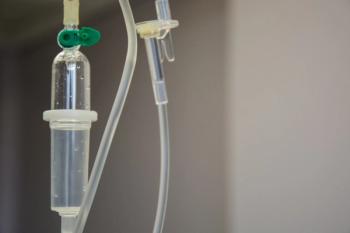
Antimicrobial Stewardship
Latest News
Latest Videos

CME Content
More News


From predicting viral outbreaks via fungal spores and combating drug-resistant gonorrhea to advancing fungal detection through genomic sequencing and improving antiviral resistance testing for vulnerable patients, and more.

Cases and deaths in the state are down from the 2 previous years. Here are some clinical considerations, treatment options, and prevention strategies in relation to these infections.

New evidence-based recommendations prioritize timely, targeted therapy and a symptom-focused classification to optimize treatment outcomes and antimicrobial stewardship.

Analysis by Carly Ching, PhD, reveals that global AMR policies overemphasize human health while neglecting farmer-focused messaging that could improve adoption and impact.

Marketed as Orlynvah, oral sulopenem from Iterum Therapeutics was FDA approved last fall for uncomplicated urinary tract infections and has shown efficacy against infections caused by Escherichia coli, Klebsiella pneumoniae, and Proteus mirabilis.

In our latest podcast, Tim Gauthier, PharmD, BCPS, BCIDP, discusses all things pathogens and antibiotics. He also details the opportunities presented for antimicrobial stewardship when it combines diagnostics and treatment duration.

Study findings underscore value of obtaining sputum culture prior to initiating antibiotics for greater detection of pathogens without opportunistic bacteria of uncertain clinical relevance.

If approved, Spero Therapeutics and GSK’s antibiotic, tebipenem HBr, could be the first oral carbapenem for US patients with complicated urinary tract infections (cUTIs).

TAXIS Pharmaceuticals announced it received a $2.9 million federal grant, which will allow the company to further advance its efforts with its dihydrofolate reductase inhibitors for the rapidly spreading and antibiotic-resistant strain of Neisseria gonorrhoeae.

Innoviva Specialty Therapeutics’ antibiotic is the first and only FDA-approved cephalosporin indicated to treat Staphylococcus aureus bacteremia, including right-sided endocarditis, caused by the methicillin-resistant Staphylococcus aureus.

The international organization’s first set of guidelines for this serious condition are looking to reduce mortality and morbidity.

In our latest From Pathogen to Infectious Disease Diagnosis podcast, bioMérieux Chief Medical Officer Chuck Cooper, MD, discusses the burden of resistance and insights on the company’s novel Vitek Compact Pro ID/AST system, which looks to identify infectious disease in a timely manner and aid clinicians in diagnosing patients, streamlining antimicrobial treatment, and avoiding severe complications such as sepsis.

A large retrospective cohort study demonstrates greater resistance across different pathogens in this patient population compared with those who do not have cancer.

Jennifer Cohn, MD, MPH, calls for better data, drug access, and care tracking to address gaps in treatment.

WikiGuidelines produces novel clinical practice guidelines developed with pragmatic, applicable methodology, including a diverse author group.

An "alarmingly" wide treatment gap for antimicrobial-resistant infections in under resourced countries is attributed to multiple factors including barriers to access.

De-escalating empiric antimicrobial therapy is a strategy to combat antimicrobial resistance. Antimicrobial stewardship programs can play a major role in preserving antibiotic effectiveness and preventing unnecessary antibiotic use.

Sean Nguyen PharmD, BCIDP, medical director Shionogi, delves into the European cohort portion of the study and offers further information from the trial and some of its bigger clinical ramifications.

Prompts in Computerized Order Entry Improve Antimicrobial Treatment for Skin, Soft Tissue Infections
The INSPIRE 3 trial demonstrates that computerized order entry recommendation prompts can reduce empiric use of broad-spectrum antibiotics in favor of targeted treatment for skin and soft tissue infections.

From the discovery of penicillin to PK-PD principles: A brief historical overview and what we have learned from recent clinical trials.

A preclinical study shows the antibiotic, piperacillin, was effective at much lower dosages than doxycycline, and did so without disrupting the gut microbiome.

Rifaquizinone is a dual-pharmacophore antibiotic combining rifamycin and a fluoroquinolone-like compound, showing strong bactericidal activity against resistant Staphylococcus aureus strains and biofilms, with promising results for treating prosthetic joint infections (PJI) but limited oral bioavailability.

A recent study evaluated bundled ambulatory stewardship interventions (ASIs) — audits, reporting, webinars, and electronic alerts — to reduce inappropriate antibiotic prescriptions (IAPs) for acute uncomplicated bronchitis (AUB).




























































































































































































































































































